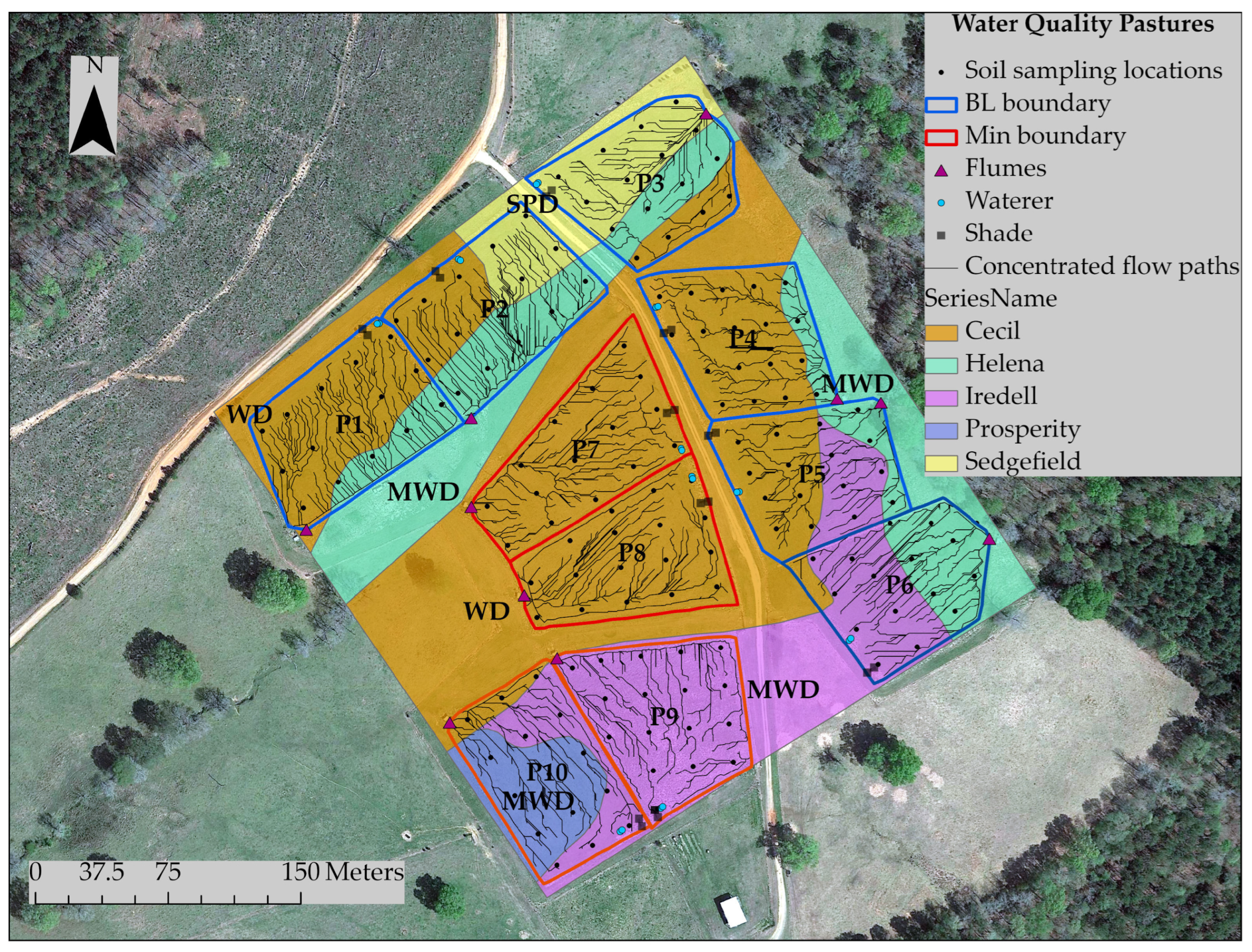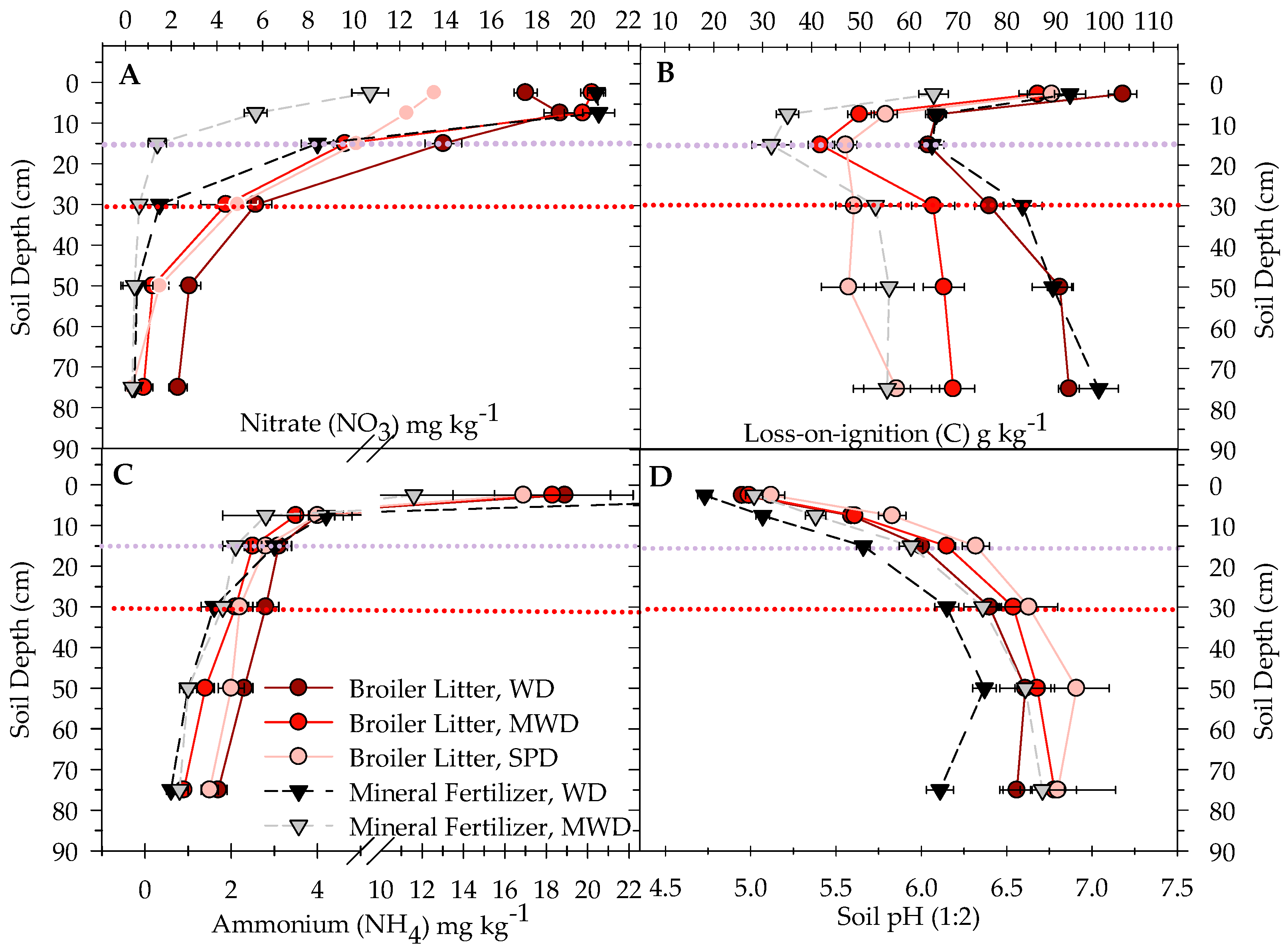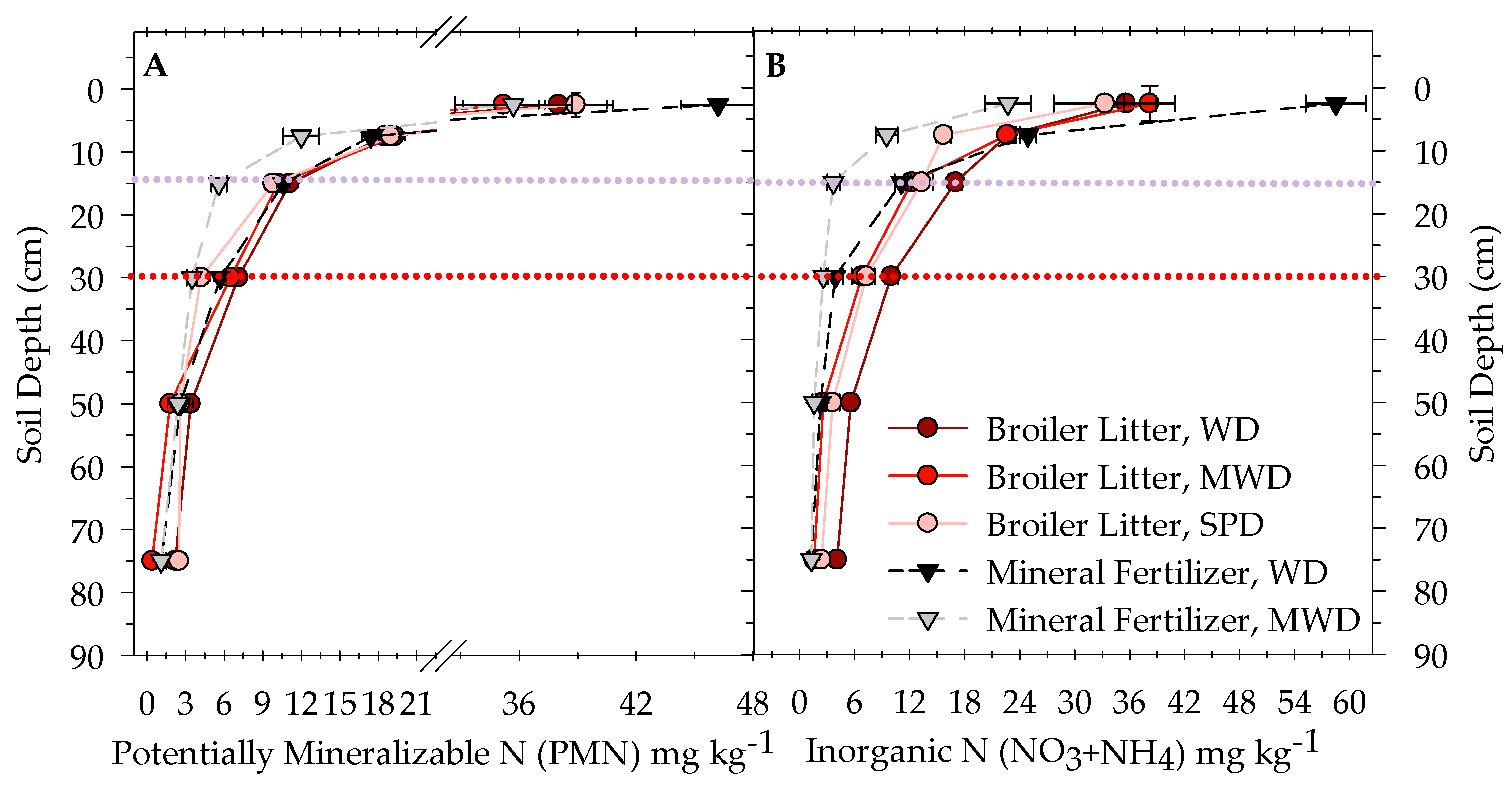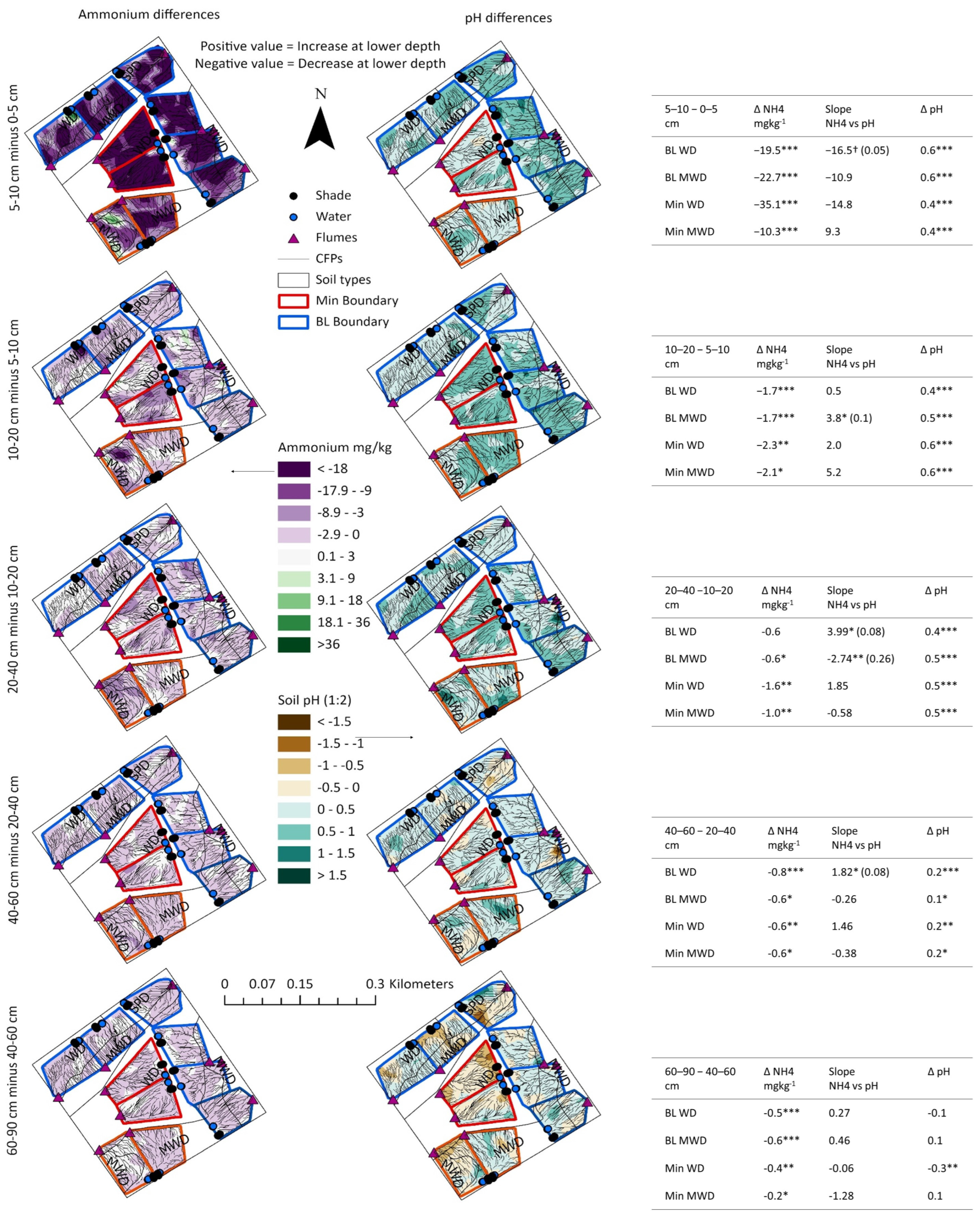Vertical Distribution of Carbon and Nitrogen in Pastures Fertilized with Broiler Litter or Mineral Fertilizer with Two Drainage Classes
Abstract
:1. Introduction
2. Materials and Methods
2.1. Study Site
2.2. Design of Experiment
2.3. Soil Sampling and Drainage Class Determination
2.4. Analysis of Soil Samples
2.5. Mapping Distribution and Differences of Soil Properties
2.6. Statistical Analysis
3. Results and Discussion
3.1. Fertilization Legacy Influence on NO3− and NH4+
3.2. Fertilizer Legacy Influence on C, IN, and PMN
3.3. Drainage Class Influence on NO3−, NH4+, and C
3.4. Drainage Class Influence on IN, and PMN
3.5. Relationship between C, IN, and PMN
3.6. Relationship between Soil pH and Nitrogen
3.7. Difference in NO3− and C with Depth and Interaction of Differences
3.8. Difference in NH4+ and pH with Depth and Interaction of Differences
4. Conclusions
Author Contributions
Funding
Institutional Review Board Statement
Informed Consent Statement
Data Availability Statement
Acknowledgments
Conflicts of Interest
References
- Marshall, S.B.; Mullen, M.D.; Cabrera, M.L.; Wesley Wood, C.; Braun, L.C.; Guertal, E.A. Nitrogen budget for fescue pastures fertilized with broiler litter in major land resource areas of the southeastern US. Nutr. Cycl. Agroecosystems 2001, 59, 75–83. [Google Scholar] [CrossRef]
- Ashworth, A.J.; Chastain, J.P.; Moore, P.A., Jr. Nutrient characteristics of poultry manure and litter. Anim. Manure Prod. Charact. Environ. Concerns Manag. 2020, 67, 63–87. [Google Scholar]
- Kingery, W.L.; Wood, C.W.; Delaney, D.P.; Williams, J.C.; Mullins, G.L. Impact of long-term land application of broiler litter on environmentally related soil properties. J. Environ. Qual. 1994, 23, 139–147. [Google Scholar] [CrossRef]
- United States Department of Agriculture, NASS Southern Region. Poultry—Production and Value. 2023 Summary. 2024. Available online: https://downloads.usda.library.cornell.edu/usda-esmis/files/m039k491c/b2775j31b/9k4213149/plva0424.pdf (accessed on 13 June 2024).
- Luxhøi, J.; Elsgaard, L.; Thomsen, I.K.; Jensen, L.S. Effects of long-term annual inputs of straw and organic manure on plant N uptake and soil N fluxes. Soil Use Manag. 2007, 23, 368–373. [Google Scholar] [CrossRef]
- He, Z.; Tazisong, I.A.; Senwo, Z.N.; Zhang, D. Soil properties and macro cations status impacted by long-term applied poultry litter. Commun. Soil Sci. Plant Anal. 2008, 39, 858–872. [Google Scholar] [CrossRef]
- Franzluebbers, A.J.; Stuedemann, J.A. Soil-profile organic carbon and total nitrogen during 12 years of pasture management in the Southern Piedmont USA. Agric. Ecosyst. Environ. 2009, 129, 28–36. [Google Scholar] [CrossRef]
- Lin, X.; Yu, S.; Yang, D.; Hutchins, M.G.; Ding, J.; Hong, B.; Chen, P.; Liu, X. Discriminating surface soil inorganic nitrogen cycling under various land uses in a watershed with simulations of energy balanced temperature and slope introduced moisture. J. Hydrol. 2020, 587, 124950. [Google Scholar] [CrossRef]
- Soil Survey Staff. Soil Survey Manual. Agricultural Handbook, No. 18; US Department of Agriculture-Soil Conservation Service, US Government Printing Office: Washington DC, USA, 1993.
- IUSS Working Group WRB. World Reference Base for Soil Resources 2014, Update 2015 International Soil Classification System for Naming Soils and Creating Legends for Soil Maps; World Soil Resources Reports No. 106; FAO: Rome, Italy, 2015. [Google Scholar]
- Ghani, A.; Müller, K.; Dodd, M.; Mackay, A. Dissolved organic matter leaching in some contrasting New Zealand pasture soils. Eur. J. Soil Sci. 2010, 61, 525–538. [Google Scholar] [CrossRef]
- Murphy, N.P.; Furman, A.; Moshe, S.B.; Dahlke, H.E. Comparison of reactive transport and non-equilibrium modeling approaches for the estimation of nitrate leaching under large water application events. J. Hydrol. 2024, 628, 130583. [Google Scholar] [CrossRef]
- Chen, C.; Hall, S.J.; Coward, E.; Thompson, A. Iron-mediated organic matter decomposition in humid soils can counteract protection. Nat. Commun. 2020, 11, 2255. [Google Scholar] [CrossRef]
- Teague, R.; Kreuter, U. Managing grazing to restore soil health, ecosystem function, and ecosystem services. Front. Sustain. Food Syst. 2020, 4, 534187. [Google Scholar] [CrossRef]
- Mian, I.A.; Riaz, M.; Cresser, M.S. The importance of ammonium mobility in nitrogen-impacted unfertilized grasslands: A critical reassessment. Environ. Pollut. 2009, 157, 1287–1293. [Google Scholar] [CrossRef] [PubMed]
- Sahrawat, K.L. Factors affecting nitrification in soils. Commun. Soil Sci. Plant Anal. 2008, 39, 1436–1446. [Google Scholar] [CrossRef]
- Steiner, C.; Teixeira, W.G.; Lehmann, J.; Nehls, T.; de Macêdo, J.L.V.; Blum, W.E.; Zech, W. Long term effects of manure, charcoal and mineral fertilization on crop production and fertility on a highly weathered Central Amazonian upland soil. Plant Soil 2007, 291, 275–290. [Google Scholar] [CrossRef]
- Miller, J.; Beasley, B.; Drury, C.; Larney, F.; Hao, X. Influence of long-term application of composted or stockpiled feedlot manure with straw or wood chips on soil cation exchange capacity. Compost. Sci. Util. 2016, 24, 54–60. [Google Scholar] [CrossRef]
- Cabrera, M.L. Personal Communication; University of Georgia: Athens, GA, USA, 2020. [Google Scholar]
- Burt, R. Soil Survey Laboratory Methods Manual. In Soil Survey Investigations Report No. 42, Version 4.0; Natural Resources Conservation Service, United States Department of Agriculture: Washington, DC, USA, 2004. [Google Scholar]
- Doane, T.A.; Horwáth, W.R. Spectrophotometric determination of nitrate with a single reagent. Anal. Lett. 2003, 36, 2713–2722. [Google Scholar] [CrossRef]
- Kempers, A.J.; Zweers, A. Ammonium determination in soil extracts by the salicylate method. Commun. Soil Sci. Plant Anal. 1986, 17, 715–723. [Google Scholar] [CrossRef]
- Fu, M.H.; Xu, X.C.; Tabatabai, M.A. Effect of pH on nitrogen mineralization in crop-residue-treated soils. Biol. Fertil. Soils 1987, 5, 115–119. [Google Scholar] [CrossRef]
- Donn, M.J.; Menzies, N.W. Simulated rainwater effects on anion exchange capacity and nitrate retention in Ferrosols. Soil Res. 2005, 43, 33–42. [Google Scholar] [CrossRef]
- Feder, F.; Oliver, R.; Rakotoarisoa, J.; Muller, B.; Scopel, E. Geochemical properties of variable charge soil explain the low nitrogen bioavailability. Commun. Soil Sci. Plant Anal. 2020, 51, 2022–2037. [Google Scholar] [CrossRef]
- Hingston, F.J. A review of anion adsorption. In Adsorption of Inorganics at Solid-Liquid Interfaces; Anderson, M.A., Robin, A.J., Eds.; Ann Arbor Science Publishing: Ann Arbor, MI, USA, 1981; pp. 51–90. [Google Scholar]
- Spark, D.L. Sorption Phenomena on Soils. In Environmental Soil Chemistry, 2nd ed.; Academic Press: San Diego, CA, USA, 2003; Volume 5, pp. 133–186. [Google Scholar]
- Toner, C.V., IV; Sparks, D.L.; Carski, T.H. Anion exchange chemistry of Middle Atlantic soils: Charge properties and nitrate retention kinetics. Soil Sci. Soc. Am. J. 1989, 53, 1061–1067. [Google Scholar] [CrossRef]
- Li, H.; Santos, F.; Butler, K.; Herndon, E. A critical review on the multiple roles of manganese in stabilizing and destabilizing soil organic matter. Environ. Sci. Technol. 2021, 55, 12136–12152. [Google Scholar] [CrossRef] [PubMed]
- Soil Survey Staff, Natural Resources Conservation Service, United States Department of Agriculture. Official Soil Series Descriptions. Available online: https://soilseries.sc.egov.usda.gov/OSD_Docs/C/CECIL.html (accessed on 8 February 2024).
- Prout, J.M.; Shepherd, K.D.; McGrath, S.P.; Kirk, G.J.; Haefele, S.M. What is a good level of soil organic matter? An index based on organic carbon to clay ratio. Eur. J. Soil Sci. 2021, 72, 2493–2503. [Google Scholar] [CrossRef]
- Strong, D.T.; Sale, P.W.G.; Helyar, K.R. The influence of the soil matrix on nitrogen mineralisation and nitrification. IV. Texture. Soil Res. 1999, 37, 329–344. [Google Scholar] [CrossRef]
- Sissoko, A.; Kpomblekou, A.K. Carbon decomposition in broiler litter-amended soils. Soil Biol. Biochem. 2010, 42, 543–550. [Google Scholar] [CrossRef]
- Gu, B.; Doner, H.E. Adsorption of hydroxy-Al polycations and destabilization of illite and montmorillonite suspensions. Clays Clay Miner. 1990, 38, 493–500. [Google Scholar] [CrossRef]
- Rasmussen, C.; Heckman, K.; Wieder, W.R.; Keiluweit, M.; Lawrence, C.R.; Berhe, A.A.; Blankinship, J.C.; Crow, S.E.; Druhan, J.L.; Hicks Pries, C.E.; et al. Beyond clay: Towards an improved set of variables for predicting soil organic matter content. Biogeochemistry 2018, 137, 297–306. [Google Scholar] [CrossRef]
- Johnson, K.; Purvis, G.; Lopez-Capel, E.; Peacock, C.; Gray, N.; Wagner, T.; März, C.; Bowen, L.; Ojeda, J.; Finlay, N.; et al. Towards a mechanistic understanding of carbon stabilization in manganese oxides. Nat. Commun. 2015, 6, 7628. [Google Scholar] [CrossRef]
- Saggar, S.; Adhikari, K.; Giltrap, D.; Luo, J.; Palmada, T.; Berben, P.; Lindsey, S.; Sprosen, M. Improving the accuracy of nitrous oxide emission factors estimated for hotspots within dairy-grazed farms. Sci. Total Environ. 2022, 806, 150608. [Google Scholar] [CrossRef]
- Soares, M.R.; Alleoni, L.R.F. Contribution of soil organic carbon to the ion exchange capacity of tropical soils. J. Sustain. Agric. 2008, 32, 439–462. [Google Scholar] [CrossRef]







| Pastures | Pasture Area (m2) | Fertilization Legacy | Number of Samples (WD/MWD/SPD) |
|---|---|---|---|
| P1 | 7891 | Broiler Litter | 15 (11/4/0) |
| P2 | 7878 | Broiler Litter | 15 (6/5/4) |
| P3 | 7106 | Broiler Litter | 16 (4/3/9) |
| P4 | 7004 | Broiler Litter | 18 (15/3/0) |
| P5 | 7124 | Broiler Litter | 16 (8/8/0) |
| P6 | 7188 | Broiler Litter | 16 (0/16/0) |
| BL Total | 96 (44/39/13) | ||
| P7 | 7800 | Mineral Fertilizer | 15 (15/0/0) |
| P8 | 7579 | Mineral Fertilizer | 17 (17/0/0) |
| P9 | 7753 | Mineral Fertilizer | 17 (0/17/0) |
| P10 | 7648 | Mineral Fertilizer | 15 (3/12/0) |
| Min Total | 64 (35/29/0) |
| Drainage Classes | Depth to Water Table | Depth to Redoximorphic Features | Depth to Concretions at WQPs |
|---|---|---|---|
| Well drained | More than 150 cm | No redoximorphic features due to good aeration | Not available at 90 cm sampling depth |
| Moderately well drained | 75 cm to 150 cm | 30 to 150 cm | Few to common concretions at 30 cm |
| Somewhat-poorly drained | 50 cm to 75 cm | 15 cm to 75 cm | Few to common concretions at 15 cm |
| Soil Depth | BL NO3− | Min NO3− | BL NH4+ | Min NH4+ | BL Soil pH | Min Soil pH |
|---|---|---|---|---|---|---|
| ---cm--- | ---mg NO3-N kg−1 Soil--- | ---mgNH4-N kg−1 Soil--- | ---(1 Soil:2 H2O)--- | |||
| 0–5 | 18.4 (0.4) A1a | 19.0 (0.6) Aa | 18.3 (1.7) Ab | 23.7 (2.5) Aa | 5.0 (0.0) Ea | 4.8 (0.0) Fb |
| 5–10 | 18.1 (0.5) Aa | 14.5 (0.8) Bb | 3.8 (0.4) Ba | 3.2 (0.5) Ba | 5.6 (0.0) Da | 5.2 (0.0) Eb |
| 10–20 | 11.8 (0.5) Ba | 4.5 (0.6) Cb | 2.8 (0.2) Ca | 2.4 (0.2) Ca | 6.1 (0.0) Ca | 5.8 (0.0) Db |
| 20–40 | 5.3 (0.5) Ca | 1.0 (0.5) Db | 2.6 (0.2) Ca | 1.8 (0.2) Db | 6.5 (0.0) Ba | 6.3 (0.1) Cb |
| 40–60 | 2.3 (0.4) Da | 0.5 (0.4) Eb | 2.0 (0.1) Da | 1.0 (0.1) Eb | 6.7 (0.1) Aa | 6.5 (0.1) Bb |
| 60–90 | 1.4 (0.3) Ea | 0.4 (0.2) Eb | 1.2 (0.1) Ea | 0.8 (0.1) Fb | 6.7 (0.1) Aa | 6.4 (0.1) Ab |
| Range (0–90) | 0–33.2 | 0–34.3 | 0–87.4 | 0–108.7 | 4.3–8.1 | 4.2–7.6 |
| Soil Depth | BL C | Min C | BL IN | Min IN | BL PMN | Min PMN |
|---|---|---|---|---|---|---|
| ---cm--- | ---g C kg−1--- | ---mg IN kg−1 Soil--- | ---mg N kg−1--- | |||
| 0–5 | 99.0 (2.2) A1a | 82.8 (2.6) Ab | 36.4 (1.6) Aa | 40.7 (2.8) Aa | 37.1 (1.5) Ab | 44.1 (1.7) Aa |
| 5–10 | 58.9 (1.3) Da | 53.8 (1.9) Cb | 22.0 (0.6) Ba | 20.7 (1.0) Ba | 19.1 (0.5) Ba | 16.3 (0.7) Bb |
| 10–20 | 54.9 (1.4) Ea | 55.8 (2.3) Ca | 15.4 (0.5) Ca | 8.5 (0.6) Cb | 11.0 (0.3) Ca | 9.0 (0.4) Cb |
| 20–40 | 66.1 (2.5) Ca | 78.5 (3.4) Ba | 8.7 (0.6) Da | 3.6 (0.5) Db | 6.6 (0.3) Da | 4.6 (0.4) Db |
| 40–60 | 80.8 (2.3) Ba | 80.2 (3.6) Ba | 4.5 (0.4) Ea | 2.0 (0.4) Eb | 2.7 (0.2) Ea | 2.4 (0.3) Ea |
| 60–90 | 87.3 (2.4) B†a | 81.9 (3.7) Ba | 3.2 (0.3) Fa | 1.3 (0.2) Fb | 1.6 (0.2) Fa | 1.1 (0.3) Fb |
| Range (0–90) | 10.3–214.7 | 15.7–166.4 | 0.4–107.8 | 0.2–137.0 | 0–127.2 | 0–89.3 |
Disclaimer/Publisher’s Note: The statements, opinions and data contained in all publications are solely those of the individual author(s) and contributor(s) and not of MDPI and/or the editor(s). MDPI and/or the editor(s) disclaim responsibility for any injury to people or property resulting from any ideas, methods, instructions or products referred to in the content. |
© 2024 by the authors. Licensee MDPI, Basel, Switzerland. This article is an open access article distributed under the terms and conditions of the Creative Commons Attribution (CC BY) license (https://creativecommons.org/licenses/by/4.0/).
Share and Cite
Subedi, A.; Franklin, D.; Cabrera, M.; Espinoza, N.; Gaur, N.; Pederson, D.; Stewart, L.; Westmoreland, C. Vertical Distribution of Carbon and Nitrogen in Pastures Fertilized with Broiler Litter or Mineral Fertilizer with Two Drainage Classes. Soil Syst. 2024, 8, 85. https://doi.org/10.3390/soilsystems8030085
Subedi A, Franklin D, Cabrera M, Espinoza N, Gaur N, Pederson D, Stewart L, Westmoreland C. Vertical Distribution of Carbon and Nitrogen in Pastures Fertilized with Broiler Litter or Mineral Fertilizer with Two Drainage Classes. Soil Systems. 2024; 8(3):85. https://doi.org/10.3390/soilsystems8030085
Chicago/Turabian StyleSubedi, Anish, Dorcas Franklin, Miguel Cabrera, Natalia Espinoza, Nandita Gaur, Dee Pederson, Lawton Stewart, and Chad Westmoreland. 2024. "Vertical Distribution of Carbon and Nitrogen in Pastures Fertilized with Broiler Litter or Mineral Fertilizer with Two Drainage Classes" Soil Systems 8, no. 3: 85. https://doi.org/10.3390/soilsystems8030085







